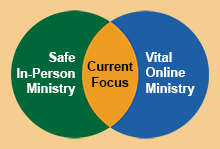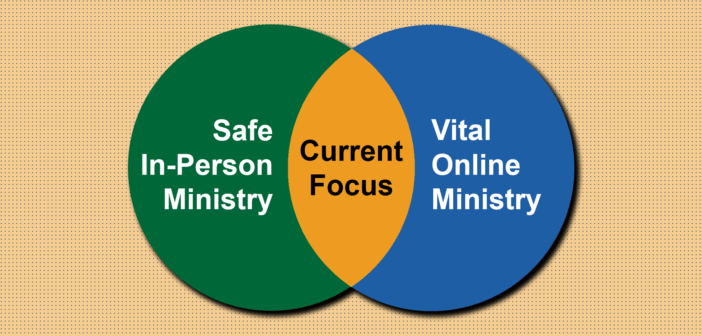Tom Berlin says churches will likely need a hybrid ministry model with a mix of in-person and online ministry for some time. He shares thoughts on how churches can embrace this approach and focus their efforts as they move forward.
Are you barraged by a cacophony of voices with conflicting advice on what your church should do next? Open immediately. Stay closed. Make it safe. Don’t wait too long. Get back to normal. Embrace the new normal. Consider present health risks and offer what you did in the past. And all of this as quickly as possible! It’s easy to feel like the double-minded person plagued by doubt and blown this way and that by conflicting opinions and the siren’s song of urgency. (James 1:8)
You recognize that even as quarantine orders are lifted, the global pandemic is not going away. And a hybrid ministry with a mix of in-person and online offerings is likely to be in place for some time. So how can you help your congregation and leadership embrace this approach? And how best can you focus your limited time, energy, and resources in the midst of this sea of change?
1. State your values clearly.
Clearly stated, shared values serve us well in such a time. They serve as deep pilings to moor your ministry in a time of rough weather. When Floris United Methodist Church moved to online ministry, we stated that our decisions would flow out of three values: keep people healthy; create vital community; and care for the vulnerable. Last week our Church Council (governing body) added a new value: continue to adapt and innovate ministry.
Clearly communicating these values has taken the pressure off reopening in-person worship, allowing us to focus our work on the needs of our community and church. These values reflect the sentiments of our members, but clearly articulating them gives members an anchor to hold to as they form their opinions. When we affirmed the additional value of continue to adapt and innovate ministry, it gave church staff and volunteers the green light to take risks, to be creative and innovative, within the bounds of the first value, keep people healthy.
2. Set a realistic timeframe.
When this started, I hoped it would last two to three months. I miss my naïve self. Last week our Church Council agreed that we would be in a hybrid form of ministry, fully sustaining online ministry for at least 18 months. We chose an 18-month timeframe because it is the most hopeful timeline for a vaccination to be delivered for the general public. (A congregational survey showed that 28 percent of those responding said they would not return to in-person worship until a vaccination was available.) But more importantly, many said that online worship was something they would do more of in the future. I hope it won’t be 18 months until a vaccine is available. But affirming this timeline allows us to commit fully to developing a hybrid approach. And the great news is that the online portion of this work engages the digital natives, the generations we so desperately need to reach.
3. Resume in-person ministry before in-person worship.
 Think of a simple Venn diagram with two overlapping circles. The left circle represents “Safe In-Person Ministry” and the right “Vital Online Ministry.” In this unusual time, clergy and lay leaders should prioritize ministries in the area of overlap. Begin by asking what it means to return to in-person ministry. Notice that I did not say in-person worship. Although the talk of in-person worship overshadows every other ministry in the current debate, worship is not the first step.
Think of a simple Venn diagram with two overlapping circles. The left circle represents “Safe In-Person Ministry” and the right “Vital Online Ministry.” In this unusual time, clergy and lay leaders should prioritize ministries in the area of overlap. Begin by asking what it means to return to in-person ministry. Notice that I did not say in-person worship. Although the talk of in-person worship overshadows every other ministry in the current debate, worship is not the first step.
Start small. How can you begin to improve pastoral care? One pastor is offering “front yard/local park visits” while wearing a mask. Another pastor talked on the phone to an older member sitting on the inside of a glass patio door. It was safe but felt more personal than a Zoom meeting. How could small groups meet outside? How could Alcoholics Anonymous safely meet in a large room? What you learn from these gatherings will help you safely resume in-person worship when the time is right.
As you think through the left side of the diagram, consider broad areas of ministry like worship, discipleship, congregational care, and service to others, and ask: What forms of community service are the most important at this time? What ministries are easier to resume in-person and would be helpful to the emotional and spiritual health of your members? What safety boundaries must be maintained?
4. Make a long-term commitment to online ministry.
Online ministry may feel strange, frustrating, and alien to those who see it as a concession needed to survive the weird world of the COVID-19 quarantine. But in truth, many effective churches have offered online worship for years. And, if they are serious about their stated desire to share Christ with their community and minister to members, churches that have adopted online worship in this period should continue. Don’t avoid the important work of extending your online worship presence while pining to get everyone back inside a building as soon as possible.
Consider the Vital Online Ministry on the right side of your diagram. Start by asking what aspects you would continue if COVID-19 miraculously disappeared tomorrow. Churches of all sizes have rapidly and admirably offered basic online ministry. Children’s ministries have provided materials and activities so families can equip children in Christian discipleship. Student ministry leaders are meeting with teenagers online, offering Bible studies and social activities. Virtual small groups are appealing to many. Pastors and musicians have gained new skills as they offer online worship, devotional resources, and concerts. Make a list of every aspect of your current online ministry and congratulate yourself! Then take stock of what you have learned. What has worked well? What can be improved or expanded? What should be dropped? And what further investments are needed?
This is Church!
When Floris UMC first offered online worship years ago, the associate pastor hosting the live chat went through a lengthy process to trademark her favorite statement — This is Church™. It reminded her that online worship and ministry really was worship and really was church. Your church has never been closed. But its ministry has been fundamentally changed. Now is the time to consider thoughtfully a hybrid approach to ministry for at least another 18 months, if not forever.
Related Resources
- Why Reopening a Church is Different by Alex Shanks
- Digital Church Is Here to Stay by Carey Nieuwhof
- Get Ready for the New Normal by Doug Powe






